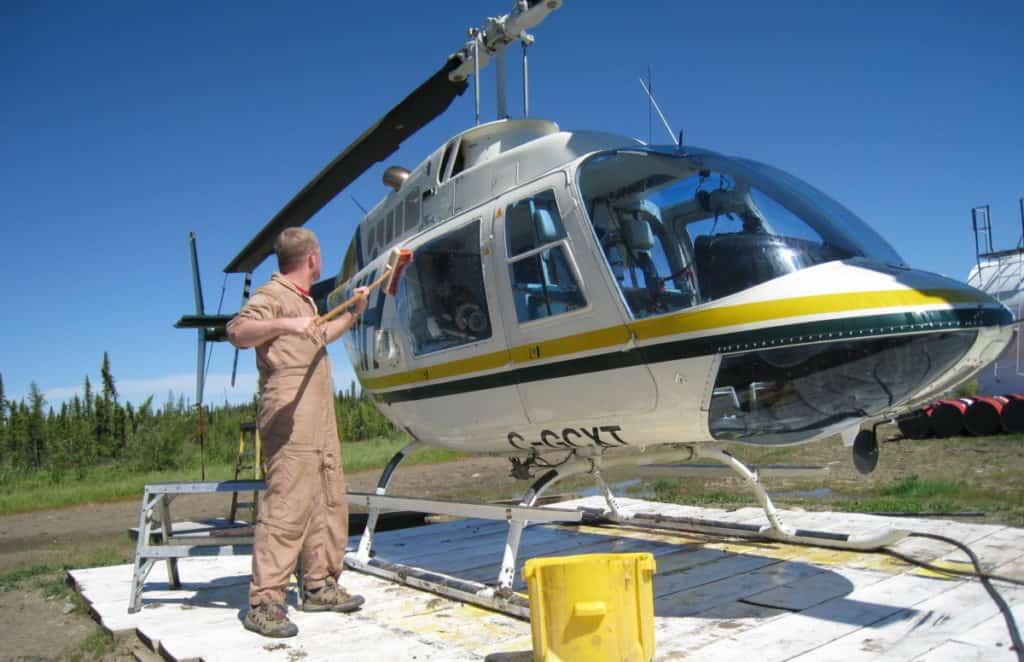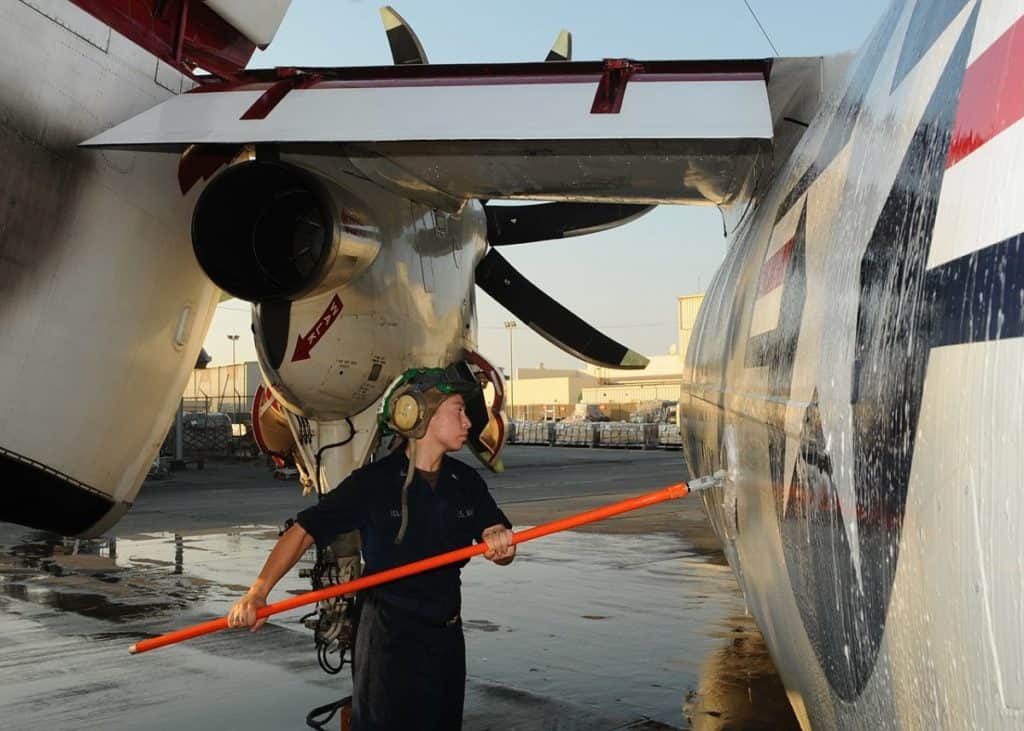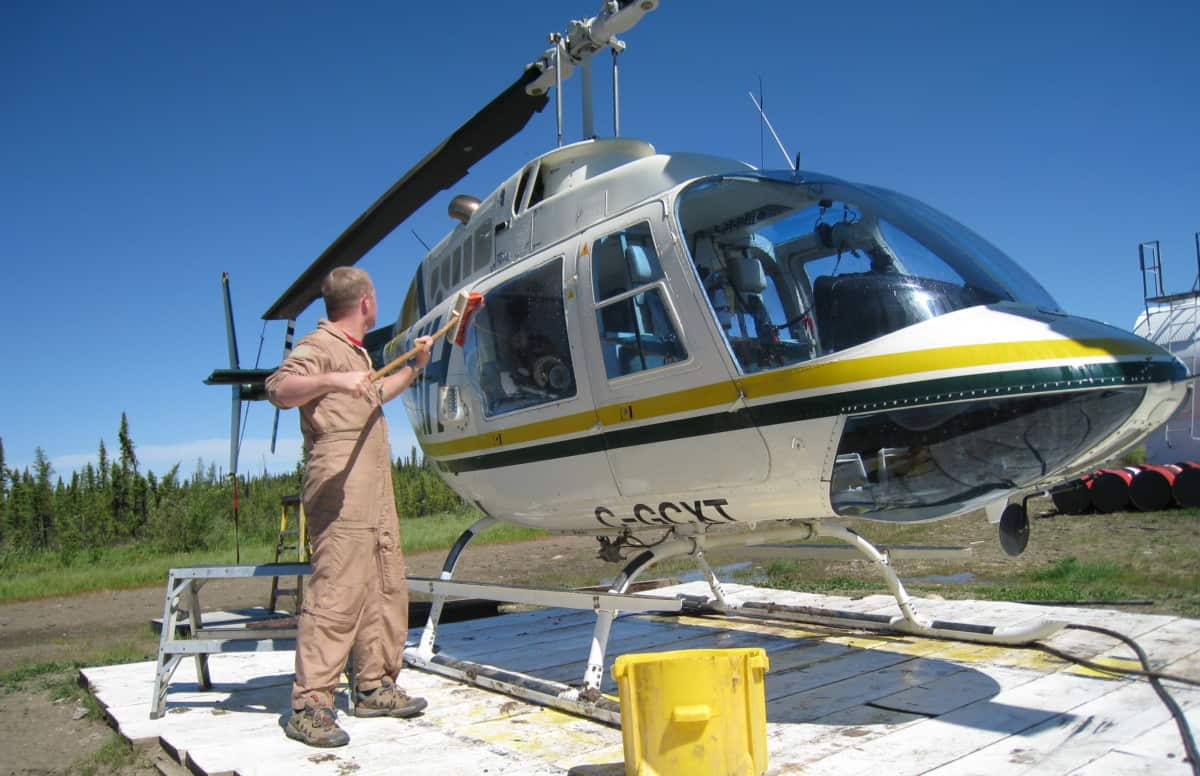
We all know how quickly our cars seem to get dirty, even from just a rainstorm! So when you are sitting at the airport and you see two airplanes sitting at the gates and one is considerably shinier than the next the question arises “How do they Wash an Airplane?”
On average, most large commercial airliners get washed about every 1 – 6 months. They can be washed using soap and pressure washers, Scrubbing pads and chemicals, or dry washed with devices similar to a Swiffer mop. Smaller aircraft get washed as required depending on their workload and environment.
I personally like my aircraft to be kept clean, Yes that is me above giving a Bell 206 Jet Ranger a bath. A clean aircraft allows for easier inspections and a more professional image to customers and the public but there is also a lot more to it than meets the eye.
If you wish to find out more about how, when, and where aircraft get a bath then please read on…
Why Do Airplanes Get Washed?
Dirt, oil, and grease build-up on aircraft fuselages as they fly. This dirt, accumulated over a very large fuselage can add up to over 1 tonne thus reducing the cargo, passengers, baggage, and fuel it can carry. The dirt also creates drag increasing the fuel burn as it flies.
We have all seen how dirty a freshly washed car can become after a rain shower passes and this is the same for aircraft. Flying in and out of the world’s most populated cities exposes the airplane to the dirt, dust, and pollution that envelopes these areas.
As the aircraft flies through the clouds, the wet fuselage attracts the dirt and allows it to cling to the surface. As the plane finishes its flight this moisture evaporates but leaves behind the dirt and grime. If those locations are also hot, then the grime can get baked on like concrete!
Drag & Weight
This dirt can begin to add up to considerable weight if left unattended. If the airplane regularly flies into dusty, humid, and polluted environments it can accumulate at a rapid rate.
The more weight an airplane has, the less useful load its engines will be able to lift. This useful load includes fuel, passengers, cargo, and baggage. The first thing that gets reduced is the amount of fuel it can carry.
Generally, the pilots will never know how much weight of dirt is on the aircraft, but what they will notice is how much extra fuel it takes to fly a certain leg. To lift more weight off the ground the engines have to produce more thrust. To produce more thrust requires more fuel to be burnt.

Just like towing an RV behind a truck, it will use far more fuel to tow that RV 200 miles than just driving in the truck without the RV, the airplane is the same except the dirt is the RV!
The second disadvantage to an airplane being covered in dirt, dust, and grime is the amount of drag it creates. To push an airplane through the air, the smoother the fuselage, the easier it is to push. This is why race cars are always spotless at the start of a race.
When the dirt begins to build up on the fuselage of an airplane it begins to make that smooth aircraft surface feel rough. This rough surface increases its drag. The more drag the aircraft has, the more fuel it burns trying to push it through the air for the same airspeed.
Fuel costs for an airplane are already astronomical and account for between 10-15% of an airline’s entire operating budget for the year. Burning extra fuel because an airplane is dirty is an unnecessary cost that airlines cannot accept. Because of this, aircraft are washed frequently.
Learn More…
Try These Articles:
* Captain, First Officer, or Co-Pilot: What is the Difference?
* What Fuel Do Aircraft Use? – Same As Your Car???
How Do Airplanes Get Washed?
There are 3 main ways an aircraft get washed and the size of the aircraft usually dictates which way it gets cleaned:
1. Wet Wash
The wet wash is very similar to how most of us wash our own vehicles. It consists of a bucket of soapy water, a brush, and a hose.
In the case of large commercial airliners like a Boeing 747 or Airbus A380, there are far more tools required like boom lifts, pressure washers, and specialized brushes, but in general, the procedure is the same for your car but on a much larger scale!
Firstly all sensitive openings and sensors are covered to prevent water from penetrating into them. Pitot tubes, static pressure ports, air ducts, and vents are the usual culprits requiring covers to be installed.
Next, the washing team will split up to take separate areas of the aircraft and apply purposely-designed aircraft soap that breaks down the grease and grime build-up but protects the paint and components from being chemically attacked by the soap.
Next, the crews begin brushing every surface while using high-pressure water hoses to rinse the aircraft thoroughly. As you can imagine the amount of water that this uses can total thousands of liters. Because of this, airlines will either have a dedicated aircraft washing bay/s that recycles the water or will use one of the methods coming up next.
For small aircraft, this is how it is always washed.

Join My Newsletter & Get Great Tips, Information and Experiences To Help You Become a Superb Pilot!
2. Dy Wash
The dry wash is a technique developed by Emirates Airlines in Dubai as they realized how much water it was going to take to keep their ginormous fleet of aircraft clean, in particular their Airbus A380 fleet.
They developed the dry wash where the cleaning crews would spray on a specialized cleaning agent to the outside of the aircraft, allow it to sit for several minutes to break down the grease and grime, and then use purposely-design mops to wipe the aircraft clean.
This is similar to how you would clean your oven for example.
By developing this technique it allowed Emirates to not require purpose-built cleaning bays, it did not require the masking or covering of sensitive aircraft components and it required practically no water.
This is now becoming one of the most preferred methods of cleaning large aircraft.
3 Semi-Dry Wash
The semi-dry wash is a combination of the previous two techniques but uses very little water. It is similar to how you mop a floor. A bucket and mop are used to apply soapy water to the aircraft which is then scrubbed to remove the dirt and grime. The mops are then wrung out to remove excess water and the cleaner sponge is moved over the fuselage to collect the dirty water, leaving the aircraft nice and clean.
This method requires a lot of manual effort but does not require aircraft components to be masked off and the water usage is minimal. One downside is the buckets of water and mops must be maneuvered around the aircraft as the crewmember works.
Learn More…
Try These Articles:
* This Is Why Pilots Reduce Thrust After Takeoff
* Before Taking Off – What Do Pilots Check?
Where Do Airplanes Get Washed?
Depending on the size of the aircraft there can be purpose-built indoor or outdoor washing bays with water recycling facilities, designated hangers with all the cleaning supplies and mobile equipment, or if the aircraft is small it can be washed out on the apron or in any general hanger.
When I wash my helicopter it can easily be done inside during the winter months or out in the sun while parked on the apron when the weather is nice. This can easily be accomplished with just a mop, bucket, and a step ladder.
As aircraft become larger they will need to have boom lifts or purpose-built stands or gantries to allow crews access to every part of the aircraft. Most large airliners will either be sent to a designated washing facility at the airport and be washed by a third-party contractor or can be washed in the airline’s own dedicated space.
When larger aircraft need washing it can take a team of 6-15 crew members an entire shift to completely wash an aircraft. Because of this, most airplanes are washed in a dedicated area so all the tools, supplies, and access equipment are on hand.
No matter if the aircraft is dry washed or wet washed, the dirty water or cleaning rags all need to be recycled and this is made easier when all the facilities are in one location to look after both the cleaning and the disposal in environmentally friendly ways.


